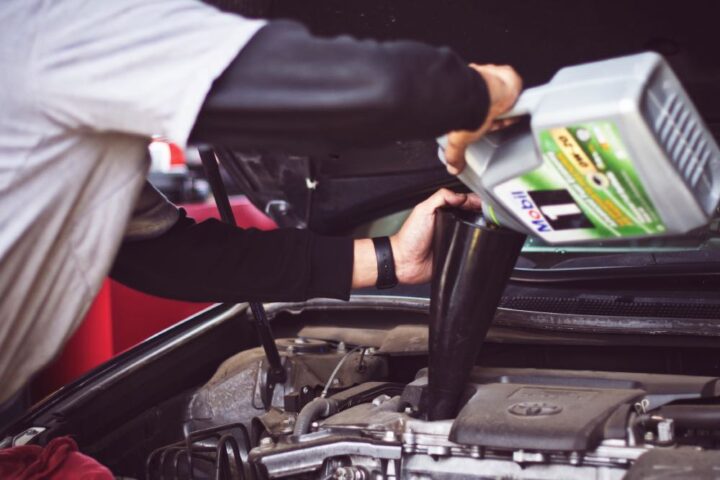Oil Pressure Low Stop Engine – What it is & How to Fix it
Preserving suitable engine oil pressure is essential for your car to run smoothly and last. Resolving oil pressure low stop engine issues fast is important. It guarantees that all of the engine’s moving elements stay lubricated, hindering any abrasion and harm.
In certain situations, the pressure of the engine oil can drop to a point where it is below the ideal amount, increasing the possibility of the engine not operating correctly.
This guide will enable you to become knowledgeable about engine oil pressure, its causes and symptoms of low pressure, as well as the steps to diagnose and repair the issue. After reading this guide, you will be ready to maintain your engine and keep your car running properly for a long period of time.

Gaining Insight into the Pressure of an Engine’s Oil
The oil pump of the engine is responsible for pushing motor oil through its various conduits and passageways with great force. This process of lubrication not only minimizes friction between vital moving parts but also allows for heat regulation as the oil absorbs the heat caused by components abrading one another.
The amount of oil pressure is normally expressed in pounds per square inch (PSI) and will vary depending on the particular engine, its design, and the viscosity of the oil. Keeping the oil pressure at the manufacturer-recommended level at various engine speeds is essential for the motor to have a long life and to protect the engine oils.
In many vehicles, an oil pressure gauge or sensor is installed to measure oil pressure in real-time. These instruments typically alert the driver if the oil pressure falls below the safe level by activating a warning light on the dashboard. Also read about check engine light flashing before stopping, a similar issue.
It is essential to keep the oil’s efficiency in check in order to sustain the right oil pressure. Adding high-quality oil additives can boost the performance of all conventional semi- and fully synthetic engine oils. This will result in increased horsepower, improved fuel economy, and reduced wear.
A unique mixture of cutting-edge solid ceramic lubricants is what makes this micro-ceramic lubricating oil additive stand out among the rest. It is suitable for use with all types of engine and gear oils, including conventional, semi- and fully synthetic. This product is a world leader in ceramic additives.
Indications and Reasons for Low Oil Pressure Difficulties
There are a few indications and sources of low oil viscosity and reduced oil pressure difficulties.
Reasons
It is possible that your engine has low oil pressure, which could be due to various factors. The most frequent causes of this issue are:
- Oil supply is inadequate: One of the major causes for a decrease in oil pressure is having a depleted oil amount in the motor. It is important to be conscientious about examining the oil level and to replenish as needed.
- Oil that has deteriorated: As time passes, the oil in the engine can become degraded or contaminated, which can lead to decreased performance and decreased oil pressure. To keep your engine running properly, it’s essential to replace the oil at the suggested intervals.
- Malfunctioning oil pressure sensor or gauge: An incorrect display of data may happen if the oil pressure sensor or gauge is not working properly. In this situation, the real issue is not with the oil pressure, but with the measuring instruments.
- Oil pump deterioration: Over time, the oil pump, which circulates oil through the engine, can suffer from wear and tear, resulting in a diminished ability to pump oil and thus a drop in pressure.
- Hindrances in oil pathways: Sludge or dirt in the engine can impede the movement of oil, resulting in low oil pressure if the oil passages become blocked or limited.
Differentiating Features
The distinguishing characteristics of something can be identified by certain signs and symptoms.
Recognizing a drop in engine oil pressure in a timely manner can help avert serious engine damage. These are some of the most frequent indicators:
- Warning Indication of Oil Pressure: The warning light on your dashboard is the most noticeable sign of low oil pressure. If the light is illuminated, it is essential to examine the oil level and pressure promptly.
- Unusual Noises: The lack of adequate oil pressure can cause parts of the engine to rub together, potentially resulting in knocking, ticking, or a high-pitched whine.
- Engine Running Poorly: A decrease in the oil pressure may result in a diminished engine power, sluggish acceleration, and choppy idling.(see stop vehicle leave engine running)
- High Temperature: If oil pressure is inadequate, it may cause more friction which can cause the engine to get warmer and even reach overheating.
It is critical to identify and deal with any of the above indications quickly to reduce the danger of harm to the engine.
What are the Steps to Address Oil Pressure Low Stop Engine?
The effects of inadequate engine oil pressure on a vehicle can be serious and far-reaching. Possible causes include a malfunctioning oil pump, a blocked oil filter, or even a depleted oil level in the engine.
Here are some practical measures you can take to resolve low engine oil pressure:
Step One: Confirm the Level of Motor Oil
The first action to take when confronting low oil pressure is to assess the oil level. To do this, take the dipstick out, clean it, and reinsert it into the engine. Then, take it out again and see the oil level in relation to the “Add” or “Low” line. If it is lower than the mark, more oil needs to be added.
If you come across that the quantity of oil is insufficient, adding automotive oil additive may be a good option to increase the amount.
This top-of-the-range oil additive from Air-Tec is designed to improve the performance and life of your vehicle’s engine.
The sophisticated organic molecules in HIGH-CLASS Automotive Oil Additive offer unparalleled friction reduction and remarkable protection from wear and tear.
Step 2: Swap Out the Oil Filter of the Engine
A blocked oil filter is another frequent explanation for low oil pressure. Over time, dirt and other substances can build up in the filter, leading to decreased oil pressure. To remedy this, you can substitute the oil filter. Generally, it is suggested to replace the oil filter every time you switch your engine oil.
Step 3: Check and Substitute the Oil Pump, If Necessary
The oil pump in your engine is important for maintaining the correct amount of oil and adequate pressure. If this component is not working properly, it is best to replace it, which should fix the problem with low oil pressure. Note that this is a job that requires specialized tools, knowledge, and expertise, so it may be best to leave it to a professional mechanic.
To ensure the oil pump works optimally, high-grade greases should be used. Advanced Engine Tech’s store offers two exceptional lubricants: AirTec Grease G200 Multi-Purpose Plus and AirTec Grease KH150 Full Synthetic. These will bolster the oil pump’s performance.
To conclude, although tackling low engine oil pressure may seem intimidating, these steps should be followed precisely to correct the oil pan difficulty. It should be noted that if oil pressure is frequently low, it could signify a more severe, underlying mechanical issue. It is advised to seek advice from an expert in such situations.
Taking Steps to Avoid Low Oil Pressure
Preserving a sound engine oil pressure is essential to keeping a car in good working order.
Taking steps to maintain the quality of piston rings and engine bearings is important. Doing so can help to prevent wearing.
To reduce the likelihood of having low engine oil pressure, the following are some preventive steps to take:
- Periodic Oil Replacement: The best strategy for avoiding low engine oil pressure is to have your oil changed on a regular basis. As time passes, the oil accumulates contaminates and loses its lubrication properties. To make sure that the oil remains efficient and clean, it is important to exchange it according to the maker’s suggested periods.
- Choose the Appropriate Oil: Not all motor oil is created equal. The viscosity, or consistency, of the oil needs to be compatible with the specific engine type. Ignoring the right oil type can cause the oil pressure to diminish. It is best to use the oil suggested by the vehicle’s maker.
- Pay Attention to Your Oil Level: Keeping tabs on your engine’s oil level can assist in spotting a potential issue before it becomes a serious problem. Some cars show an oil pressure indicator in the dashboard; if you observe it gradually dropping, it might be a sign of insufficient oil pressure.
- Be Cautious on the Road: Excessive speeding, sudden accelerations, and abrupt braking can all contribute to the reduction of engine oil pressure due to accelerated oil degradation. To prevent such an outcome, it is suggested to drive in a more moderate manner.
When you come across a low oil pressure scenario often, it may be indicative of a more serious mechanical problem. Therefore, it is recommended to contact an experienced mechanic in this regard. Regular maintenance and oil changes can help avoid such difficulties.
You can guarantee that your oil pressure remains inside the proposed range by utilizing superior engine oil and additives such as AirTec High-Class Micro-Ceramic Oil Additive. These items help to optimize engine performance and increase its longevity.
Air-Tec High Class Injector Cleaner is formulated to clear away oil, carbon, sludge, and resin that may have built up in an engine’s fuel system. All products from Air-Tec High Class are manufactured in Germany with the utmost attention to detail, making sure that every item surpasses the expectations of customers.


